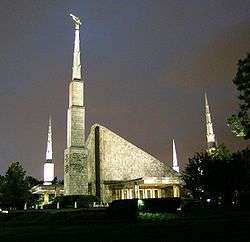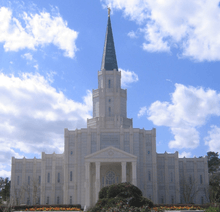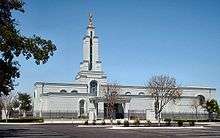The Church of Jesus Christ of Latter-day Saints in Texas

As of year-end 2010, The Church of Jesus Christ of Latter-day Saints (LDS Church) reported 296,141 members, 49 stakes,[1] three districts,[1] 557 congregations (413 wards[2] and 105 branches[2]), eight missions, and four temples in Texas.[3]
History
1844 Texas consideration for Latter-day Saint nation
Due to increased persecution around Nauvoo, Joseph Smith realized that he would have to relocate the Church outside the borders of the United States. The Republic of Texas was considered by Smith a place where the Church members would be able to peacefully practice their religion. The prophet began to negotiate with Sam Houston, president of the Texas Republic, for the southern and western portions of Texas for the future Latter-day Saint nation. Joseph Smith sent Lucien Woodworth to Austin, Texas, to meet with Houston.
Woodworth returned to Nauvoo and reported the progress he had made in May. Reports indicated plans for purchasing large tracts of land. A commission composed of Woodworth, George Miller and Almon W. Babbitt was organized to lead the final negotiations. Joseph Smith asked that Lyman Wight and Miller to prepare to lead a group of settlers to Texas with assumption that negotiations would be successful. These negotiations ended with the death of Joseph Smith in June 1844.
1845-1890s
Even though Brigham Young relocated the Church in the Great Basin, he allowed Wight to take a group of 150 to Texas. On November 10, 1845, they arrived north of present-day Dallas. Eventually, Wight and the colonists settled near a German colony of Fredericksburg and founded a town named Zodiac.
In 1848, Preston Thomas and William Martindale were sent by Brigham Young to invite Wight and the colonists to join the Church in the Salt Lake Valley. Wight declined the offer and was consequently excommunicated from the Church. Although he was no longer a member of the Church, Wight and his followers pioneered settlements in five Texas counties and generally left a good reputation for Mormons in the area.
Brigham Young sent several missionaries to preach in Texas in the 1850s. Those who joined the Church were encouraged to gather with the Saints in the Utah Territory. On December 25, 1855, a conference was established in Texas. Nearly 1,000 converts from Texas immigrated to the Great Basin prior to the Civil War.
Missionary work in Texas essentially ceased during the Civil War. But in 1875, nearly 10 years after the Civil War, missionary work in Texas resumed. The Texas Conference was once again organized in 1893.
Rural settlements and the Kelsey colony
The population of Latter-day Saints in Texas increased dramatically when Church members began to gather in Mormon enclaves within the state. Converts living in the Southern U.S. endured ostracism and occasional physical violence because of their membership in the Church. In the early 1890s, President James G. Duffin of the Southwestern States Mission suggested to Church leaders that they establish a gathering place for Southern U.S. Church Members. His suggestion was accepted and branches were organized in Missouri, Kansas and Texas. Included in the Texas colonies were Odom Settlement (also known as Odomville) near Spurger, Williamson Settlement near Evadale, Jozye (also known as Little Utah), and Poynor.
One of the most successful and long-lived colonies was located at Kelsey. It was founded by brothers John and James Edgar in December 1898. Nine Latter-day Saint families settled in the area by the fall of 1901. Elder Abraham O. Woodruff of the Quorum of the Twelve visited the site and assisted in laying out the town. On August 4, 1901, a Sunday School was organized. By the end of the month, a meetinghouse was built, and by the end of the year, a branch had been organized.[4]
Missionaries in the southern states encouraged converts to gather in Kelsey. There were approximately 400 Latter-day Saints living in the township. A school began operating in 1901 and was staffed by missionaries. Kelsey became "one of the largest branches outside the stakes of Zion."[5] Later that year, the colony was divided and the settlement of Enoch was founded and a branch was organized there.[6]
Kelsey's population reached its peak in 1923 with 750 inhabitants. The rail line was closed the same year causing the population to slowly decline. The Church-sponsored school was closed in 1943, and in 1958, the congregations in Kelsey and Enoch were combined with the Gilmer Ward.[7]
Dallas and North Texas
Nearly all Church activity in Texas occurred in rural setting. In 1913, Harriett M Knight, a widow with five children moved from Kelsey to Dallas which had no organized branch. Eliza E. Davis was the only other Latter-day Saint living in Dallas, having moved there in 1908. Other Latter-day Saints moved to Dallas over time. Missionaries occasionally visited these urban Church members, but it wasn't until 1916 that a home Sunday School was organized in Dallas. The Dallas Branch was organized sometime between 1918 and 1921.
Other urban areas began to see Latter-day Saint presence. By 1918, Latter-day Saints were living in Fort Worth, Houston, and San Antonio. However, Dallas was the first urban branch in Texas to have a meetinghouse. In 1927, Dallas Latter-day Saints moved into a vacant building formerly used by another denomination. In 1943, the North Central Texas District was organized with 500 members. A new meetinghouse was built in Dallas on Turtle Creek Blvd. in the early 1950s and dedicated by President David O. McKay on April 26, 1953. On October 18, 1953, Mark E. Peterson of the Quorum of the Twelve organized the Dallas Stake, with Ervin W. Atkerson as president.
Houston and East Texas
The first branch in Houston was organized on December 5, 1921. The first official Church-owned meetinghouse was a home willed to the Church by Mrs. Gussie Farmer. This house was quickly remodeled and dedicated on November 19, 1933. The Houston Stake was created on October 11, 1953.
In response to Hurricane Ike in 2008 members of the LDS church across Texas and other parts of the country volunteered relief and service.
As of September 20, 2008, total Church response to Hurricane Ike included:
- 80,640 hygiene kits (six truckloads).
- 8.064 cleaning kits (four truckloads).
- Four truckloads of water.
- 11,520 blankets (two truckloads).
- 4,800 food boxes (four truckloads) which include rice, vegetable oil, peanut butter, fruit drink mix, and assorted canned goods. Each food box will feed a family of four for a week to 10 days.
- Food, water, generators, sleeping bags, tools, chain saws, tarps and other items.[8]
In addition to this aid, thousands of LDS volunteers came into the area to assist in clean up efforts.
El Paso and West Texas
The city of El Paso played an important role in the establishment of the Church in Mexico and the American Southwest. In 1876, Daniel W. Jones led a company of missionaries there, where they prepared to begin missionary work in Mexico. These missionaries stayed in El Paso for several weeks, where they studied Spanish and conducted missionary work, though no conversations were recorded.
Towards the end of the 19th century and the beginning of the 20th, a few Latter-day Saint families from the Mormon colonies in Mexico relocated to El Paso and Ciudad Juárez. In July 1912 nearly 3,000 saints fled their homes in Mexico because of a revolution and made their way to El Paso, where assistance from local residents was received before leaving to settle elsewhere.
The first ward in Texas was organized in El Paso on October 11, 1918. It was originally part of the Juarez (Mexico) Stake, but was later transferred to the St. Joseph (Arizona) Stake. The Mexican Mission headquarters was located in El Paso from 1919 to 1929. The El Paso Stake became the first stake in Texas on September 21, 1952, with Edward V. Turley Sr. as President.
Texas Membership History
| Year | Membership |
|---|---|
| 1893 | 64 |
| 1898 | 300 |
| 1906 | 1,000 |
| 1930 | 3,840 |
| 1977 | 50,000 |
| 1984 | 120,000 |
| 1990 | 154,000 |
| 1999 | 210,892 |
| 2008 | 278,492 |
Missions
Responsibility for Texas has been shared by several different missions. Originally in the Southern States Mission, it was transferred to the Indian Territory Mission, which later changed its name to the Southwestern States Mission and, in 1904, it became the Central States Mission. Texas remained in the Central States Mission until the Texas Mission was organized in 1931. Texas and Louisiana were combined to form the Texas-Louisiana Mission in 1945. Texas was part of the Gulf States Mission from 1955–1960.
In 1961, a new Texas Mission was organized. This became the Texas Dallas Mission in 1974. As the Church grew, other missions in Texas were organized.
| Mission | Organized |
|---|---|
| Texas Dallas Mission | February 16, 1961 |
| Texas Houston Mission | July 3, 1976 |
| Texas Houston East Mission | July 1, 1990 |
| Texas McAllen Mission | July 1, 1989 |
| Texas Fort Worth Mission | July 1, 1986 |
| Texas San Antonio Mission | December 10, 1967 |
| Texas Houston South Mission | July 1, 1997 |
| Texas Lubbock Mission | July 1, 2002 |
- The Texas Dallas Mission was originally named Texas Mission in 1961. It was renamed the Texas North Mission on June 10, 1970, and ultimately the Texas Dallas Mission on June 20, 1974.
- The Texas San Antonio Mission was originally named Texas South Mission in 1967. It was renamed the Texas San Antonio Mission on June 20, 1974.
- The Texas Fort Worth Mission was originally named Texas Lubbock Mission in 1986. It was renamed the Texas Fort Worth Mission on January 20, 1988.
- The Texas McAllen Mission was originally named Texas Corpus Christi Mission in 1989. It was renamed the Texas McAllen Mission on February 24, 1994.
Temples
In 20 years, four temples have been built in Texas.
|
|
30. Dallas Texas | ||
|
Location: |
Dallas, Texas, US | ||
|
|
97. Houston Texas | ||
|
Location: |
Klein, Texas, US | ||
|
|
109. Lubbock Texas | ||
|
Location: |
Lubbock, Texas, US | ||
|
|
120. San Antonio Texas | ||
|
Location: |
San Antonio, Texas, United States | ||
Communities
Latter-day Saints have had a significant role in establishing and settling communities within the "Mormon Corridor" and other locations, including the following in Texas:
LDS vs FLDS
The Church of Jesus Christ of Latter-day Saints (LDS Church) is not affiliated with the Fundamentalist Church of Jesus Christ of Latter Day Saints (FLDS Church), who operate the YFZ Ranch in Texas and does not practice polygamy.[9]
See also
- Ciudad Juárez México Temple
- The Church of Jesus Christ of Latter-day Saints membership statistics (United States)
Notes
- 1 2 Texas Stakes.LDS Stake & Ward Web Sites
- 1 2 LDS Meetinghouse Locator
- ↑ LDS Newsroom (Statistical Information)
- ↑ KELSEY, TEXAS Handbook of Texas Online
- ↑ Deseret News(February 5, 1910)
- ↑ ENOCH, TEXAS Handbook of Texas Online
- ↑ James Clyde Vandygriff, The Beninnings of Kelsey, Texas.
- ↑ "Hurricane Ike: Church sends relief to Texas, Haiti; LDS volunteers give service", Church News, September 20, 2008.
- ↑ "LDS Church Reminds Media they don't Practice Polygamy". KSTU ("Fox 13"). 2008-04-11. Retrieved 2008-06-13.
References
- Michael Scott Van Wagenen, The Texas Republic and the Mormon Kingdom of God, 2002
- B.H. Roberts, Comprehensive History of the Church, v.2, 1912
- Melvin C. Johnsin, Polygamy on the Pedernales: Lyman Wight's Mormon Village in Antebellum Texas, 2006
External links
- LDS Newsroom (Texas)
- The Church of Jesus Christ of Latter-day Saints - Official Site
- The Church of Jesus Christ of Latter-day Saints - Visitors Site

